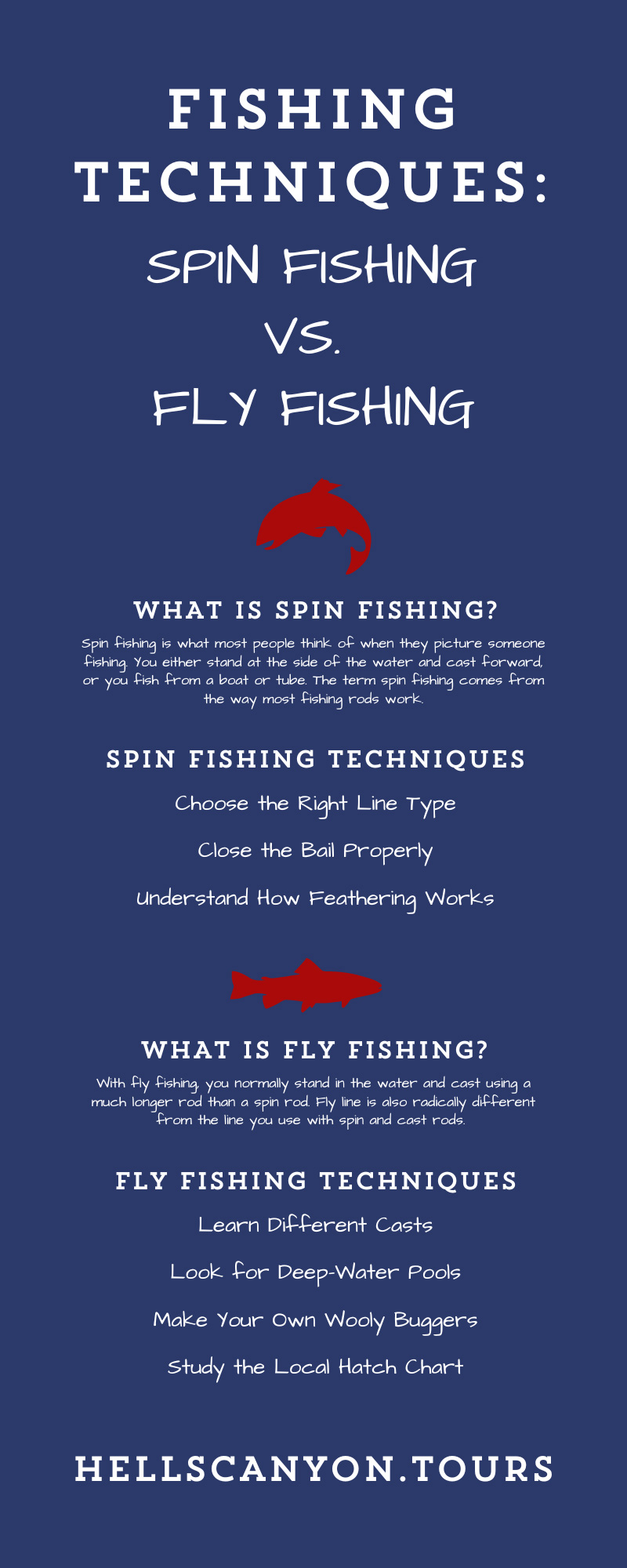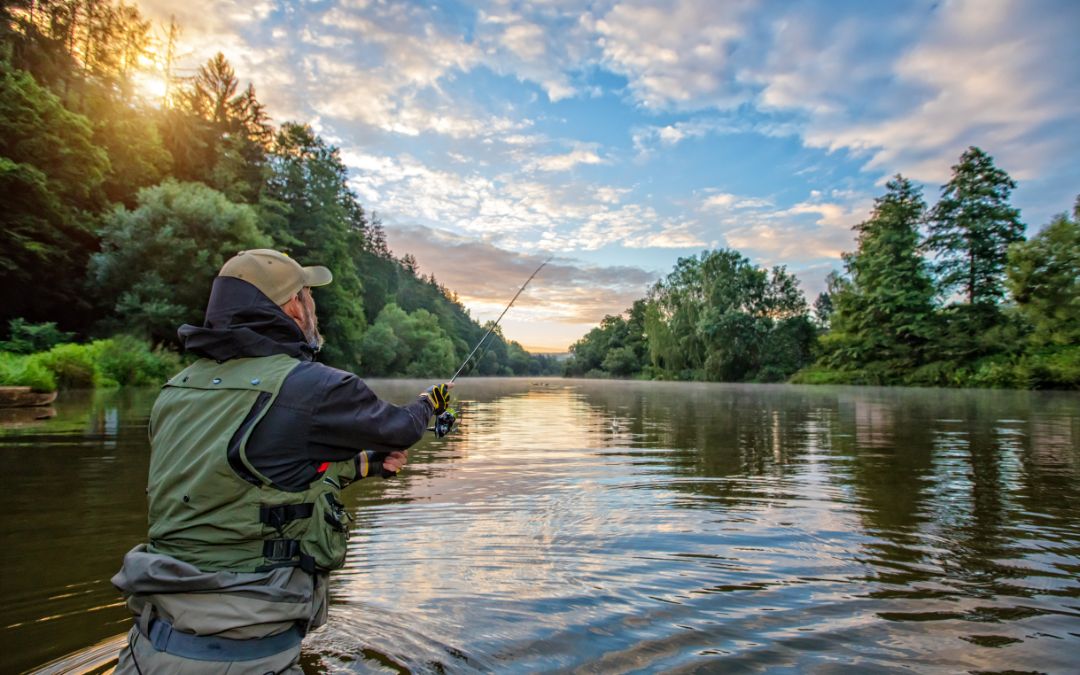If you’re an amateur angler, you’ve probably learned by now that there are many different kinds of fishing techniques. However, everything usually comes down to two types of fishing techniques: spin fishing and fly fishing. In this post, we’ll talk about the differences between the techniques and tips on how to master both.
What Is Spin Fishing?
Spin fishing is what most people think of when they picture someone fishing. You either stand at the side of the water and cast forward, or you fish from a boat or tube. The term spin fishing comes from the way most fishing rods work. When you cast using a spinner rod, the line unwinds from around a spool that turns rapidly. In many rods, you can lock the line into place once you’ve cast.
Spin fishing is incredibly versatile, and you can find rods designed specifically for all kinds of fish. There’s also a huge range of baits available for spin casters.
Spin Rods vs. Cast Rods
Other than spin rods, there’s another common class of fishing rods that you may have seen near the spin rods at the sporting goods store. These are cast rods, and you can recognize them by the egg-shaped case that covers the line spool. Cast rods are useful for beginner anglers and kids because they protect the line from getting tangled. However, they’re not quite as versatile as spin rods, so most experienced fishers avoid them.
What Is Fly Fishing?
With fly fishing, you normally stand in the water and cast using a much longer rod than a spin rod. Fly line is also radically different from the line you use with spin and cast rods. It’s often a very bright color to make it easy to see, and it’s divided into three sections: the line, the leader, and the tippet. Fly fishing also uses very small artificial baits called—you guessed it—flies.
When you go fly fishing, it’s harder to fish in a group because you’ll need a lot more space than with spin casting. To cast a fly line, you must wave the rod around in the air so the line makes a figure eight—then, you can cast. Most people consider fly fishing to be more difficult than spin fishing, and it’s better for catching certain kinds of fish, like trout.
Spin Fishing Techniques
In the next two sections, we’ll go into detail about fishing techniques for spin fishing and fly fishing. For spin fishing, you’ll need to think about line type, closing the bail, and feathering.
Choose the Right Line Type
One of the best styles of fishing line to use with a spin casting rod is braided line. This line is super strong, meaning fish will have a much harder time breaking your line. The line itself is less bulky than monofilament, keeping your reel from being too cumbersome. However, one problem with braided line is that fish can see it, which will scare some species away. What some people do to avoid this problem is tie on a leader of fluorocarbon, which is nearly invisible in water.
Close the Bail Properly
Remember how we said that some types of rods will lock the line in place for you? This is called a bail. On most spin casting rods, the bail will close by itself once you turn the reel handle, but using this automatic feature can cause tangles. It’s always best to close the bail manually to avoid any problems.
Understand How Feathering Works
One technique that really makes a difference in avoiding tangles in your line is feathering. Feathering involves resting a finger on the line against your rod to help it feed back into the reel. When you cast, feathering can also give you incredible precision with how far out your line reaches.
Fly Fishing Techniques
We suggest that everyone learn how to spin cast before learning fly fishing. Since fly fishing is very different from spin fishing, you’ll need a different set of techniques to get started.
Learn Different Casts
The basic fly fishing cast involves making a figure eight pattern with your line. However, you won’t always have the room to do this kind of casting, especially if you’re in a river that trees and bushes border. Learn a few other types of casts, including roll casting, to be able to fish wherever you want.
Look for Deep-Water Pools
Most fly fishing focuses on catching trout, which love to swim at the bottom of deep pools in rivers. When you find one of these pools, you should absolutely take some time to fish there. However, you’re going to need to weigh your line down using a heavy fly bait or extra weights.
Make Your Own Wooly Buggers
The wooly bugger is the most popular fly fishing bait because so many different fish like it. While you can purchase pre-made wooly buggers, we recommend learning how to tie your own in case you lose one while fishing. While it’s not exactly hard, you should look up a couple of guides on how to tie a wooly bugger since there are several steps.
Study the Local Hatch Chart
When you go fly fishing in a new area, you may find that the local fish don’t go for your current supply of flies. What you need to do is visit a local tackle shop and look for a hatch chart. This table tells you what kinds of insects are common in the region and what stages of development they’ll be in at different times of the year. With this information, you can switch your fly to resemble something the local fish find delectable—another reason to learn how to tie your own flies!
Go Fishing With the Experts
If you’re still learning the ropes in fishing, or you’re just looking for a successful fishing trip, check out Hells Canyon fishing tours with River Adventures. We have expert guides who know the Snake River backward and forward. They can show you all the best spots to fish and teach you techniques specific to the fish in the area. And while we don’t offer specific advice for fly fishers, you’re welcome to bring your fly fishing equipment along. Check out our website for more information, or reach out to us directly. We’d love to hear from you!


Recent Comments